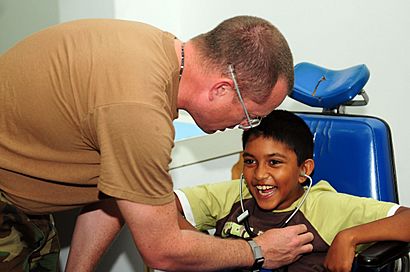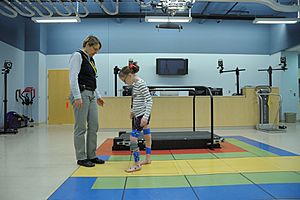Cerebral palsy facts for kids
Quick facts for kids Cerebral palsy |
|
|---|---|
 |
|
| A child with cerebral palsy being assessed by a physician | |
| Symptoms | Poor coordination, stiff muscles, weak muscles, tremors |
| Complications | Seizures, intellectual disability |
| Usual onset | Early childhood |
| Duration | Lifelong |
| Causes | Often unknown |
| Risk factors | Preterm birth, being a twin, certain infections during pregnancy, difficult delivery |
| Diagnostic method | Based on child's development |
| Treatment | Physical therapy, occupational therapy, speech therapy, conductive education, external braces, orthopedic surgery |
| Frequency | 2.1 per 1,000 |
Cerebral palsy (CP) is a group of conditions that affect how a person moves and controls their body. It happens when there is damage to the brain, usually before or during birth, or in early childhood. The word "cerebral" refers to the brain, and "palsy" means weakness or problems with using muscles. CP is a lifelong condition, but different therapies can help people manage it.
CP was first described by an English surgeon named William Little in 1860. There are different types of CP, with spastic cerebral palsy being the most common. Today, about 1 in every 400 children in the UK has cerebral palsy.
Contents
What are the Symptoms of Cerebral Palsy?
People with CP often have trouble standing or walking. Their muscles might be stiff, weak, or they might have tremors (shaking). Sometimes, parts of their body can be partly paralyzed, meaning they can't move them well.
While the main problem with cerebral palsy is difficulty with movement, people with CP might also have other challenges. These can include:
- Trouble with thinking or learning
- Difficulties with feeling things
- Problems with talking
- Behavioral issues
Many children with cerebral palsy experience other conditions too. For example:
- About 3 out of 4 children with CP have pain.
- About 1 out of 2 children with CP have an intellectual disability.
- About 1 out of 3 children with CP cannot walk on their own.
- About 1 out of 4 children with CP have epilepsy (a condition that causes seizures).
- About 1 out of 4 children with CP have trouble talking.
- About 1 out of 5 children with CP have trouble sleeping.
- About 1 out of 10 children with CP are blind or have severe vision problems.
- About 1 out of 25 children with CP are deaf or have severe hearing problems.
Most people with cerebral palsy live as long as people without CP. A small number of children with CP, about 5-10%, might pass away before adulthood.
How is Cerebral Palsy Treated?
Treating cerebral palsy is all about helping people live their best lives. It focuses on improving their quality of life, helping them make their own choices, and allowing them to be a full part of society.
Many therapies help children with CP move better. About 60% of people with CP can walk by themselves or with help when they grow up.
Types of Therapies and Aids
- Physical therapy: This helps improve strength, balance, and movement.
- Occupational therapy: This helps with daily activities like dressing, eating, and writing.
- Speech therapy: This helps with communication and sometimes with eating or swallowing.
- Braces: These are special supports worn on the legs or arms to help with movement and stability.
- Surgery: Sometimes, surgery can help improve muscle stiffness or bone problems.
- Mobility aids: Devices like walkers, crutches, or wheelchairs can help people with CP move around more easily and independently.
Images for kids
-
Micrograph showing a fetal (placental) vein thrombosis, in a case of fetal thrombotic vasculopathy. This is associated with cerebral palsy and is suggestive of a hypercoagulable state as the underlying cause.
-
RJ Mitte at the 2018 San Diego Comic-Con
See also
 In Spanish: Parálisis cerebral para niños
In Spanish: Parálisis cerebral para niños







